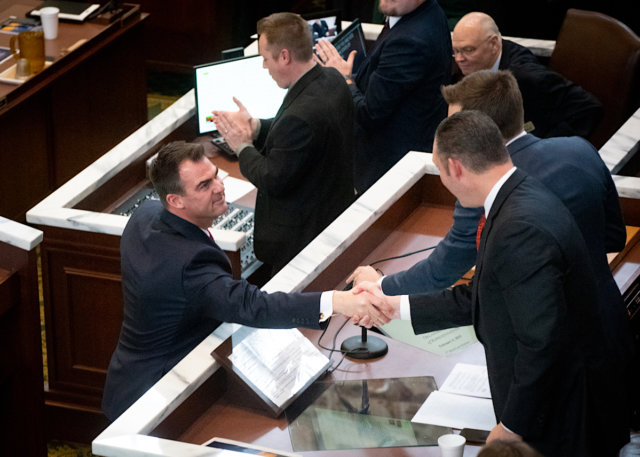

How much money does it cost to run the governor of Oklahoma’s office?
That’s a question new Gov. Kevin Stitt’s chief of staff has been trying to answer in the three months since voters elected the Tulsa businessman to become Oklahoma’s top executive.
“It’s a real frustration for us, to be perfectly honest,” Michael Junk said Monday before his boss delivered the 2019 State of the State address. “I’ve done budgets before for different offices. I ran Tom Coburn’s budget for five years, and for (Tulsa Mayor) G.T. (Bynum) obviously I engaged in the budget there. But I come here and say, ‘What’s our operating budget?’ And people kind of instruct me, ‘Here’s your $1.7 million.’ So I say, ‘Well how do you hire as many people as [Fallin] has?’ And they say, ‘Well you have to take money from over here, and there’s a revolving fund over there.’ So it’s pretty frustrating for us.”
Junk and others with knowledge about Office of the Governor budgeting confirmed that Oklahoma’s past two governors received financial support for multiple staff positions through memoranda of understanding with other state agencies.
“They’re all over the place. It’s an absolute disaster. It is the most backwards way to operate an office,” Junk said. “So we are really hoping to clean that up.”
Northrup: FY 2019 appropriation = FY 1982
The MOUs during Gov. Mary Fallin’s tenure involved the Secretary of Energy and Environment and the Office of Management and Enterprise Services, which formed in 2011 as the consolidated home for several agencies, including the Office of State Finance.
Fallin’s MOU with OMES stemmed from a similar agreement between former Gov. Brad Henry’s office and the Office of State Finance, said Denise Northrup, who served as Fallin’s chief of staff before leading OMES.
“The governor’s office budget relied on outside funds through an MOU prior to the Fallin administration,” Northrup said. “When that was fully explained to us in her first term, Gov. Fallin and staff undertook measures such as closing the Tulsa office and eliminating virtually all travel paid for with state dollars in order to reduce spending.”
State appropriations show the Office of the Governor’s budget shrinking steadily for the past 17 years. From a high of $3.1 million for FY 2002, appropriations fell to $2.3 million in FY 2010 and finally to less than $1.7 million for FY 2019.
Northrup said state economic woes and disagreements over how to raise new revenue meant the Fallin administration never had “a politically acceptable time” to seek and receive higher appropriations.
“We were unable to eliminate the dependence on outside funds, but we reduced the amount by almost half,” Northrup said. “For eight years, the office operated with 10 to 15 fewer full-time employees than the previous three governors, including several part-time employees who worked without benefits. The current appropriation is equal to that of the appropriation in FY 1982 which, with inflation, makes it even more egregious.”
Echols said Oklahomans want to see their elected officials “getting government right.”
“That is not a good way to run government when the truth is that we have governor’s office employees being placed in other agencies,” House Majority Floor Leader Jon Echols (R-OKC) said last week. “I’m glad Gov. Stitt is putting together what it really takes to run the governor’s office.”
Junk: ‘We will be completely candid’
After placing key members of his staff within the Secretary of State’s office, Stitt himself has framed the cumbersome situation as a transparency issue.
“Traditionally, the governors have borrowed money from different agencies and kind of had staff plugged in in different areas,” Stitt said a week before his State of the State address. “So it was kind of a shell game. I’m trying to bring that all back and just be transparent. I’ll ask the Legislature — here’s what we’re really utilizing in the governor’s office to be the chief executive of the state — so that’s what we’re trying to make sure that [lawmakers] know.”
When Stitt revealed his proposed executive budget Monday, however, the Office of the Governor was targeted for flat funding: the same $1.68 million it received for FY 2019.
Junk said the Stitt administration will pitch lawmakers its request for more accurate appropriations in the coming weeks.
“We will be completely candid,” Junk said. “We’ll likely go ask for more money, but it’s because we want to do it from the governor’s budget, not picking and choosing from little pots of money as has been done in the past. Not to be critical, it’s just not the way we want to do it.”
Echols and Deputy Floor Leader John Pfeiffer (R-Orlando) said they appreciate the Stitt administration’s candor about his office’s financial picture.
“I think that’s what is nice about somebody coming in from an outside perspective,” Pfeiffer said. “Because for so many years people go, ‘Well, we’ve done it this way because it’s the way we’ve had to do it to keep the adequate staff we need to run agencies but take the cuts we’ve had to take.'”
Echols agreed.
“It sets up an improper imbalance of power when the governor is forced to stash away essentially governor employees in other agencies,” he said. “That creates issues with that agency.”
Follow @NonDocMedia on:
Raises, liabilities dog Stitt office budget
In immediate terms, the governor’s office itself may be dealing with the biggest issues, as rumors circulate that a small supplemental appropriation might be necessary for the Stitt office to finish the current fiscal year.
On Jan. 20, Randy Ellis of The Oklahoman reported that Fallin approved pay raises for office staff during the final months of her term. Ellis wrote that Fallin gave raises to four employees totaling an annualized $22,000, though the raises were authorized near the midpoint of the fiscal year.
“We were very surprised by the raises that came out,” Echols said. “The Legislature didn’t know, and I still don’t know what effect the last-minute raises are going to have on the governor’s ability to function under his current budget.”
Junk said he did not know what impact the raises would have either, as only one staff member was retained during the administrative transition. But he identified other issues.
“In addition to that, we inherited a number of liabilities from the previous administration,” Junk said. “I’m paying comp time out for people who don’t work for us but who worked for the previous administration. We are looking at potentially having to pay unemployment for a couple employees who may be filing. So we have a lot of liabilities as an office that we are inheriting from the previous administration.”
Northrup said the Fallin administration sought better funding for the Office of the Governor during the 2018 legislative session’s budget negotiations.
“We strongly advocated that the governor’s office appropriation be increased by $500,000 — the approximate amount of cuts over eight years — so that the incoming governor would be able to hire a full staff,” she said. “Regretfully, that did not happen, and Gov. Stitt is left in a difficult position.”
Stitt pointed out that a U.S. senator’s office typically has a budget of about $3 million, far more than Fallin’s office was appropriated.
“I want to be transparent with Oklahomans instead of borrowing from OMES or this agency or that agency. We just want to say, ‘Here’s what it is really costing to run the governor’s office,'” Stitt said. “But the net dollars won’t change, just where we grab them from. We will try to be a lot more transparent with the Legislature and say, ‘Here’s how much we need to spend to run the executive branch.'”




















